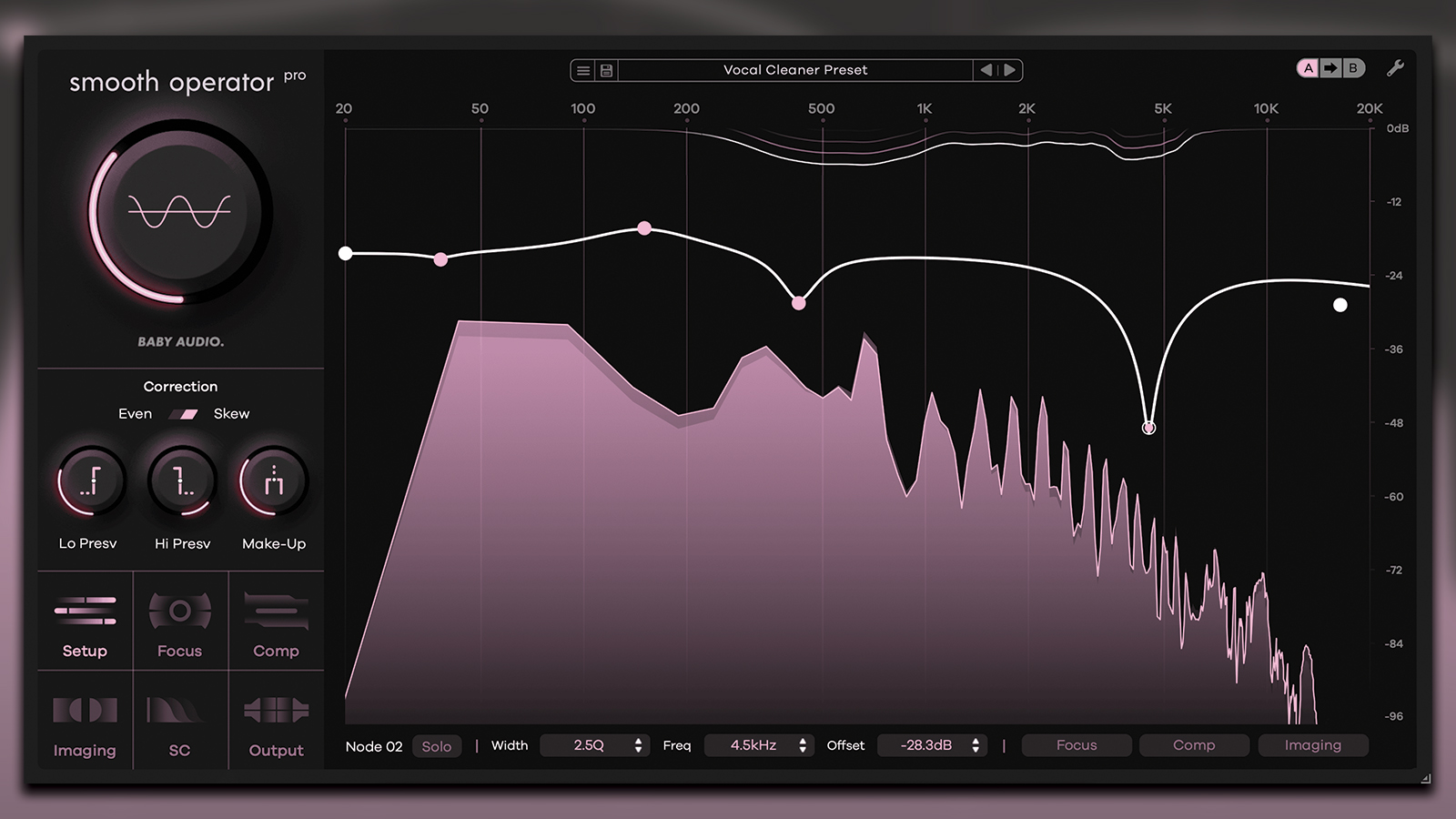Fantastic (free) synths and how to use them: TAL-NoiseMaker
We deconstruct this powerful freeware synthesizer and show you how to build a patch from the ground up
PLUGIN WEEK 2023: Whether you’re new to synthesis, or looking for something to spark some fresh creativity, knowing where to start amidst the sea of software synths can be rather daunting.
Furthermore, forums, message boards and the like are awash with claims that you need to own various, expensive synths; implying a financial barrier to entry, that in truth, simply isn’t there. There are some fantastic, free software synthesisers, which are more than enough to get your creative juices flowing.
In this article, we’ll look at TAL’s NoiseMaker; a free software synth that delivers more complexity and sophistication than one might expect from a humble freebie. We’ll begin with some fundamentals about synthesis, and then explore how the TAL-NoiseMaker makes use of them. Lastly, we’ll examine some custom (downloadable) presets which demonstrate and contextualise NoiseMaker’s attributes in practical terms.
NoiseMaker is versatile and can produce some very warm, interesting and substantial tones. Furthermore, it has an uncluttered user interface which presents the essential building blocks of subtractive synthesis, laid out in a logical way. It’s intuitive design and high quality sound make it a great option for beginners and experienced users alike.
Synthesis - a quick recap
Before we get started on the NoiseMaker, let’s quickly refresh our memories on the basic principles of how subtractive synthesis works.
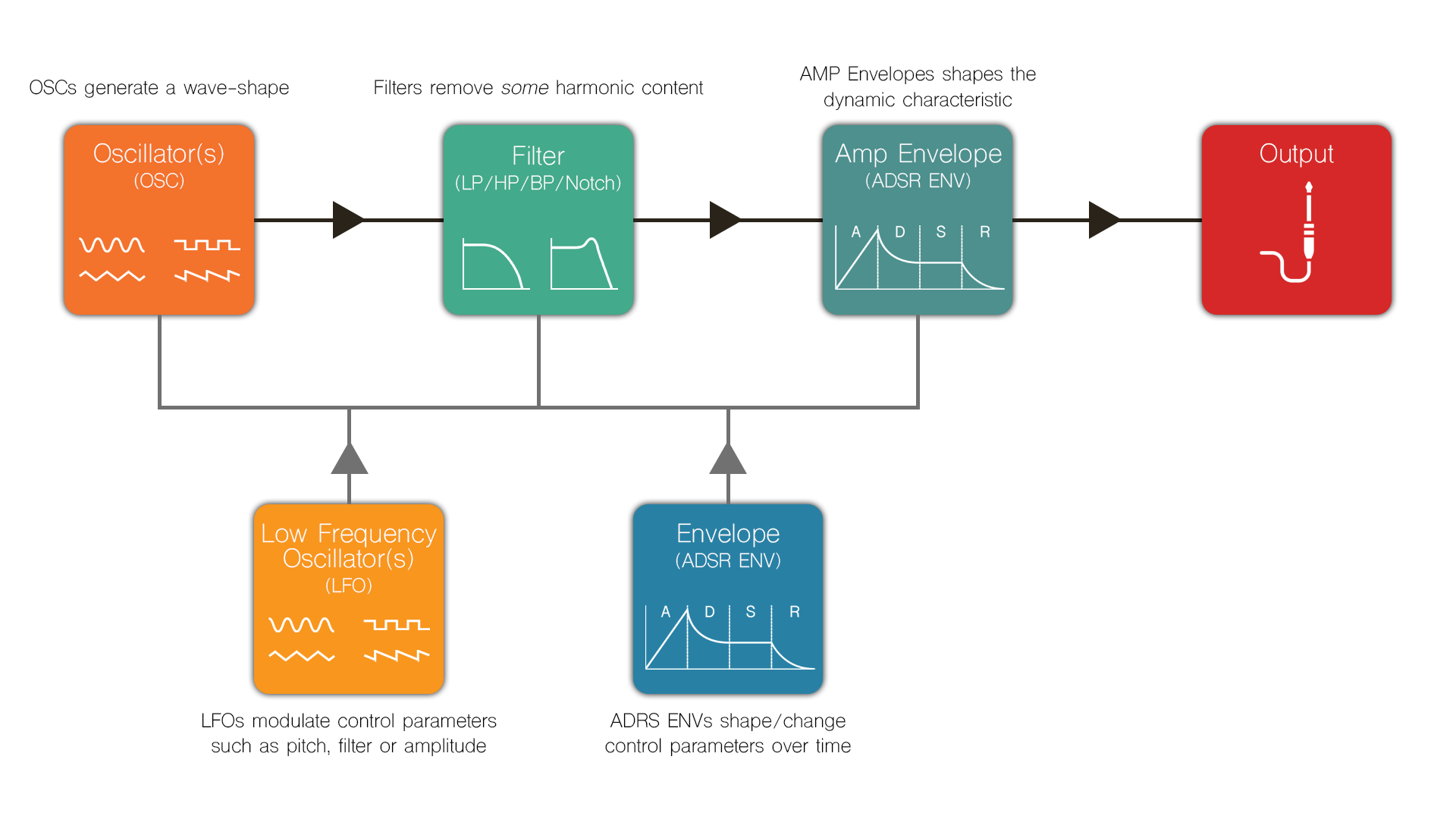
Don’t worry if you still have some questions or uncertainties. As we take a deep dive into NoiseMaker and have a go at making our own tones, things will become clearer. Now, on to the NoiseMaker.
Oscillators and master section

Dead-centre at the top of the window are the oscillators (OSC). OSC1 has three wave-shapes (saw, square, and noise). OSC2 has five wave-shapes (saw, square, triangle, sine, and noise). Other features of the OSC section are:
Get the MusicRadar Newsletter
Want all the hottest music and gear news, reviews, deals, features and more, direct to your inbox? Sign up here.
- TUNE - Adjust tuning in half-step/semitone intervals
- FINE - Adjust the fine/micro-tuning
- PHASE - Adjust the phase/polarity (only effective when combining both OSC)
- PW (OSC1) - adjusts pulse width of the square-wave
- FM (OSC2) - allows OSC1 to modulate OSC2 (explained in more detail later in the article)
If you’re unsure about the above, take a few minutes to preview each wave-shape in isolation whilst also tweaking the dials. You’ll soon become familiar with the distinct characteristics of each shape and control parameter.

The Master section allows you to set the levels of each OSC. There’s also a SUB OSC. This is a third oscillator, which is fixed to a SQUARE wave-shape and is two octaves lower than the default OSC tuning (hence the “sub” name). This is ideal for dialling in low-end grit or oomph. The Master section also includes:
- PORTA (Portamento) - The time it takes to slide or slur between notes. The drop-down menu beside this allows you to choose between ON (always on) and AUTO (only active when two notes are played/held simultaneously).
- TUNE - Adjust the fine/micro tuning of the whole synth (as opposed to individual OSC fine tuning)
- TRANSP (Transpose) - Whole-tone or whole-step tuning of the whole synth (as opposed to individual OSC transpose)
- RINGMOD (Ring Modulation) - Multiplies OSC1’s signal with OSC2’s tol create more precise upper harmonics and arguably thinning (or focusing) the mid-range harmonics
- SYNC - Synchronises the polarity/phase of the Sub OSC to OSC 1+2. This could be described as focusing the fundamental harmonic of your tone, which in turn alters the character of the overtones into a purer, thinner tone, but one that still retains low frequency depth
- VOICES - How many notes you can play simultaneously. I.e. monophony/polyphony (max. six voices)
- VOLUME - Master volume for the entire synth
Filter

The next step in tone-design is to FILTER out an area of the frequency spectrum to further tailor our tone to our desired outcome.

Whilst Low-Pass Filters (LPFs) are most commonly used on synths, NoiseMaker has added versatility with the option of changing the filter to a high-pass filter (HP), band-pass filter (BP) or Notch filter for greater tonal control and manipulation.

- LP (Low Pass) - Lets the low frequencies pass, filtering out the high frequencies
- HP (High Pass) - Lets the high frequencies pass, filtering out the low frequencies\
- BP (Band Pass) - Lets a small band-width of frequencies through, filtering out both highs and lows
- Notch - Filters out a small frequency band leaving the rest of the spectrum unaffected (it’s the opposite of a BP)
- SV (State-Variable) - Utilises filter types in a feedback-loop configuration. Don’t get bogged down in the science of this one! Try it, and you’ll hear the different tonal characteristics. If you like it, use it.
FILTER KEY allows you to set the amount of KEYBOARD TRACKING. Keyboard Tracking raises the CUTOFF for the higher portions of the keyboard, allowing for softer (more cut-off) bass notes and brighter (less cut-off) high notes.
The FILTER CONT controls how much the FILTER ENV is applied to the CUTOFF (in both + and - polarities). This should make more sense after you’ve read the ADSR ENV section below.
Envelopes

The next step in the tone-design process is ENVELOPING. NoiseMaker has two ADSR ENV; one on the FILTER and one on the AMP. There’s also a third (assignable) AD ENV in the AMP section.

The FILTER ADSR allows you to manipulate the behaviour of the FILTER over time. In the example above, the tone begins brightly and softens over time. The AMP ENV has similar settings and so the amplitude of the sound mirrors the tonal brightness.
The other parameters on the AMP ENV are as follows:
- A - Attack
- D - Decay
- AMOUNT - How much influence the AD ENV will have on the target parameter
- DEST - What parameter the AD ENV will apply to (FILTER, OSC1, OSC2, PW or FM)
LFOs
Let’s turn our attention to the LOW FREQUENCY OSCILLATORS (LFOs).

LFOs are oscillators, but they don’t form part of the audio-path. Instead, they’re used to manipulate other control-parameters of the synth. I.e. we don’t hear them, we only hear the effect they have on other parameters. There are two near-identical LFOs in NoiseMaker that consist of:
- RATE - Speed
- AMOUNT - Oscillation depth
- PHASE - If using both LFOs with the same wave-shape, this can be used to move them in or out of phase with one another
- TRIG - Toggle between the LFOs always operating, or beginning when a note is triggered
- SYNC - Sync the LFO speed with tempo of your DAW
- WAVE-SHAPE - Sine, triangle, saw, square, randomised square, noise
- DESTINATION - What will be affected by the LFO (FILTER, OSC1, OSC2, Pan, Volume (LFO2 only), alternate LFO RATE, OSC1&2 PITCH)
Let’s look at an example that will help better contextualise things.
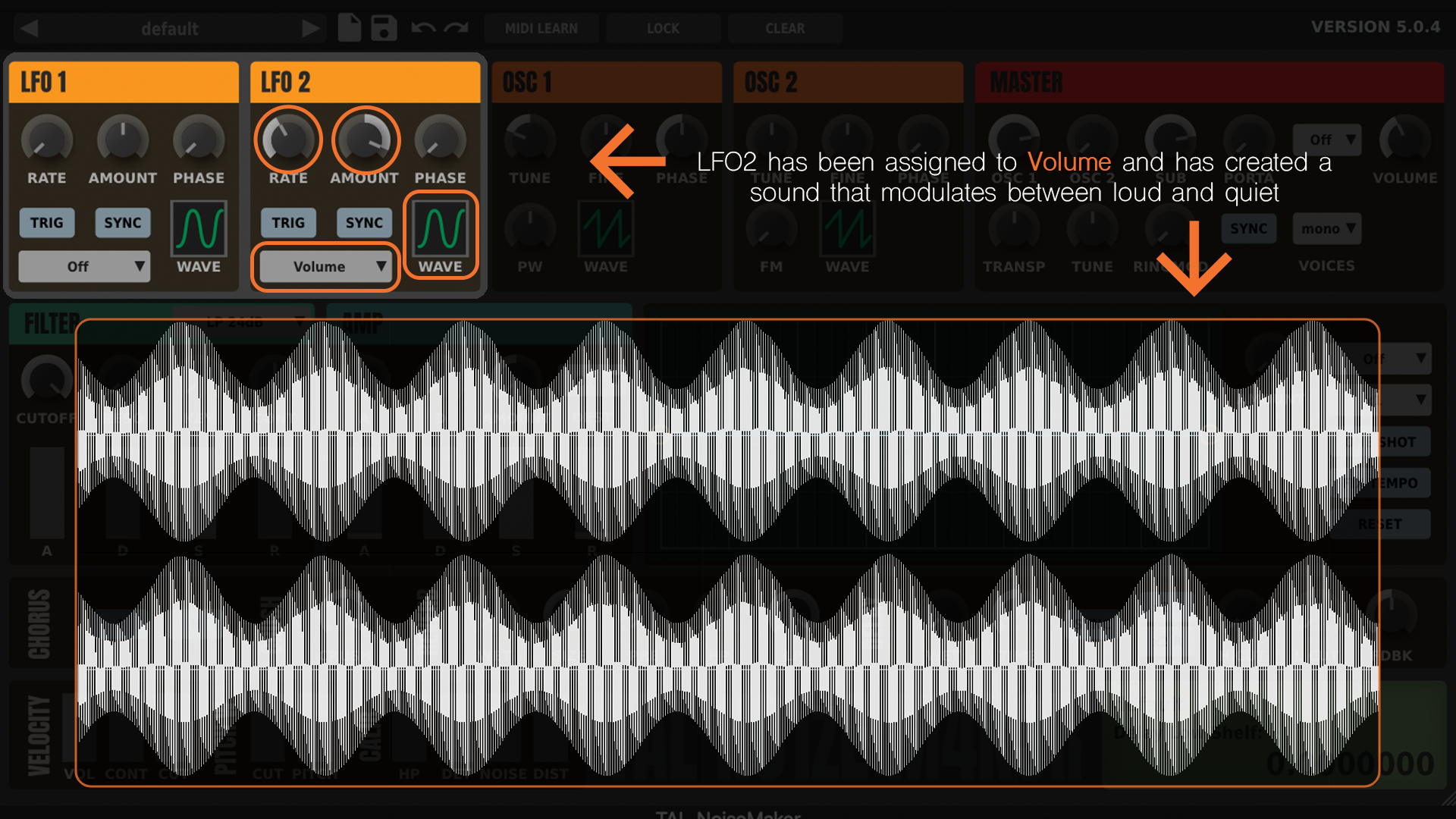
If we want our synth to have a tremolo effect, we assign an LFO to the VOLUME and set the AMOUNT and RATE to our desired levels. The amplitude of the synth will now oscillate between quieter and louder, courtesy of the LFO.
Frequency Modulation
Let’s look at some of the more unique qualities of NoiseMaker which stand it apart from other free synthesisers. FREQUENCY MODULATION (FM) is the technique of modulating one oscillator with another. NoiseMaker’s application of FM appears to take inspiration from the FM function on the (also iconic) ARP Odyssey. It’s best explained with illustration:
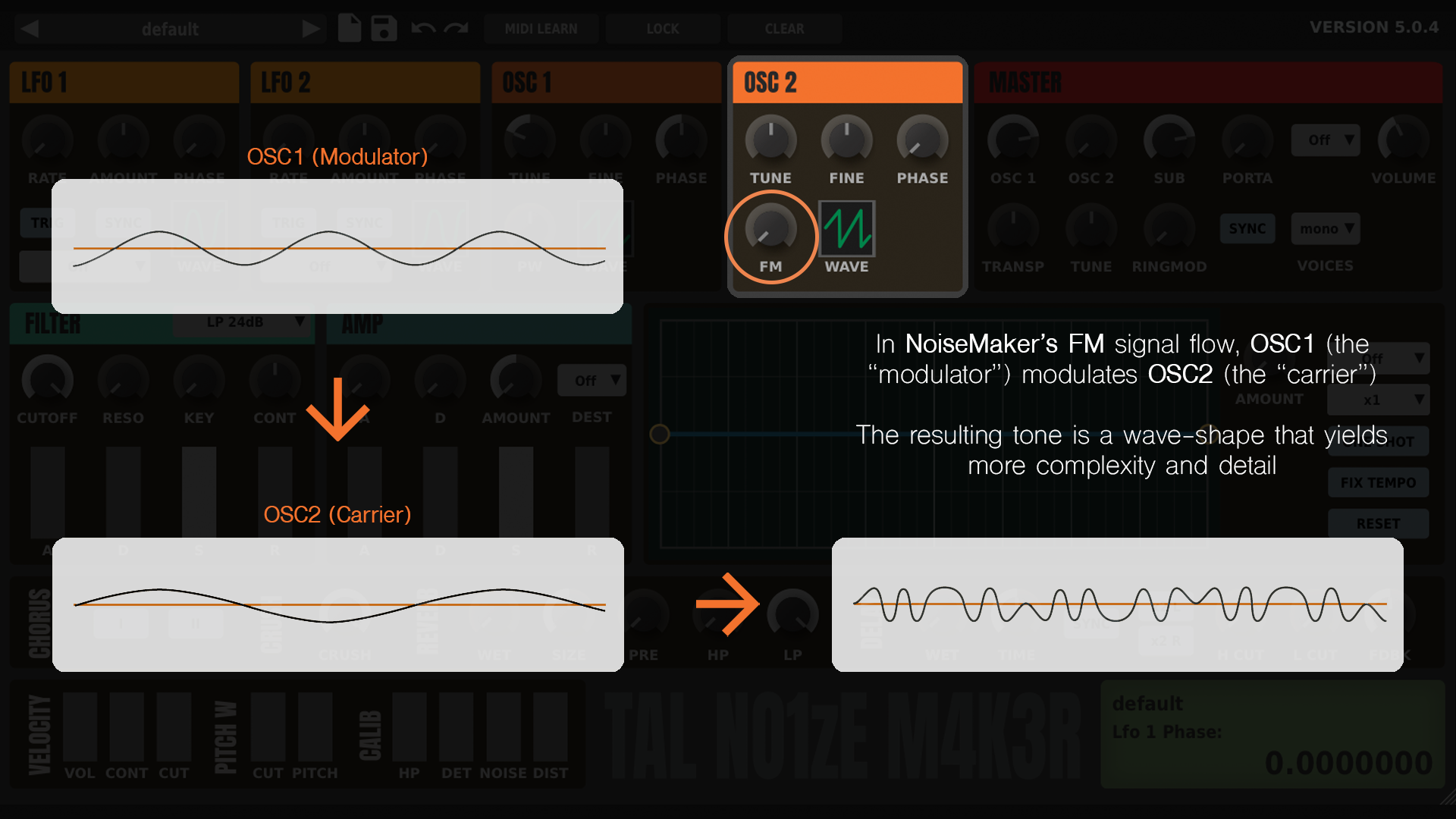
Whilst some FM synthesis techniques are used to create glassy and/or metallic tones, this (simpler) application is superb for dialling in grit, texture and harmonic interest. Turn up your FM dial and tinker with OSC1 to hear how the different wave-shapes and tunings alter the upper-harmonics of the tone.
Envelope editor
I believe this is one of NoiseMaker’s most interesting features. This is a completely customisable envelope filter that can be assigned to the FILTER, OSC1, OSC2, OSC1&2, FM, RINGMOD or VOLUME.
Simply click on it to create some waypoints (dots) and drag them around to your desired shape. Use the ASSIGN Drop-Down Box to select what will be enveloped and dial in the desired AMOUNT.

Other adjustable parameters are:
- RESOLUTION Drop-Down - Select the tempo of the ENV according to grid-division (X1, X2, X4, X8, X16, X32)
- ONE SHOT - Plays the ENV sequence once per triggered note (as opposed to looping)
- FIX TEMPO - Unsyncs the tempo of the ENV from your DAW’s tempo
- RESET - resets the ENV EDITOR curve
Effects
TAL-NoiseMaker has a simple, but very powerful effects section (signal-wise, these are post AMP ENV).

- Chorus - TAL’s Roland Juno inspired chorus. Simply choose Chorus I, Chorus II or both together for a super deep and lush chorus.
- Bit Crusher - By default, the dial is all the way to the right (highest digital resolution) and as you turn it leftward, you reduce the resolution. As you get near to the minimum value, you’ll hear lots of juicy, old-school video-game tonalities.
- Reverb & Delay - all the usual editable parameters associated with these effects.
Miscellaneous controls

The bottom rung of the synth concerns input controls and a few, final, tonal touches. Think of it like tonal seasoning.
The Velocity parameters relate to velocity sensitivity and how the synth responds to player input:
- VOL (Volume) - How sensitive the amplitude/volume is to key velocity
- CONT (Filter Contour) - Assigns the Filter’s Slope to velocity. I.e. the harder you play, the shallower (and therefore brighter) the Cut-Off Filter’s contour/slope becomes
- Cut (Cut-Off) - Assigns the FILTER CUTOFF to respond to velocity (the harder the note, the brighter the tone)
The PITCH W parameters relate to how the pitch-bend of your keyboard will behave:
- CUT - Assigns the pitch-bend input to the FILTER CUTOFF
- PITCH - Assigns the pitch-bend input to the global pitch of all OSC
The CALIB section (presumably for “calibration” although I’m not quite sure that’s the right term for this section) is more like an assortment of miscellaneous features TAL weren’t sure where to put. But that’s OK, because they’re very cool features!
- HP (High-Pass) - A High Pass Filter, ideal at the end of the signal chain. Sometimes post-Filter effects or manipulations with ENVs and/or LFOs can cause undesirable sub-bass swells (especially with high RESO settings). If you experience this, use this High-Pass Filter to help better control your low-frequencies
- DET (Detune) - This emulates some of the tuning instabilities of analogue synths and is a great way of adding some vintage warmth and tonality to your sound
- NOISE - Adds a little white noise to the signal, to dirty the sound
- DIST - Add distortion to the signal to emulate overdriven preamplifiers
Let's make some noise...
That just about wraps up our tour of the TAL-NoiseMaker. To cap off this tutorial, we're going to take a look at the mechanics of a few different patches to better contextualise what we’ve just discussed above.
We’ve included the presets we're discussing as free downloads, so you can load them into NoiseMaker while you’re reading and experimenting with your own tone design.
Download them using the link above and drop them in the following folder: Library > Application Support > ToguAudioLine > TAL-NoiseMaker > presets. They should now appear here:
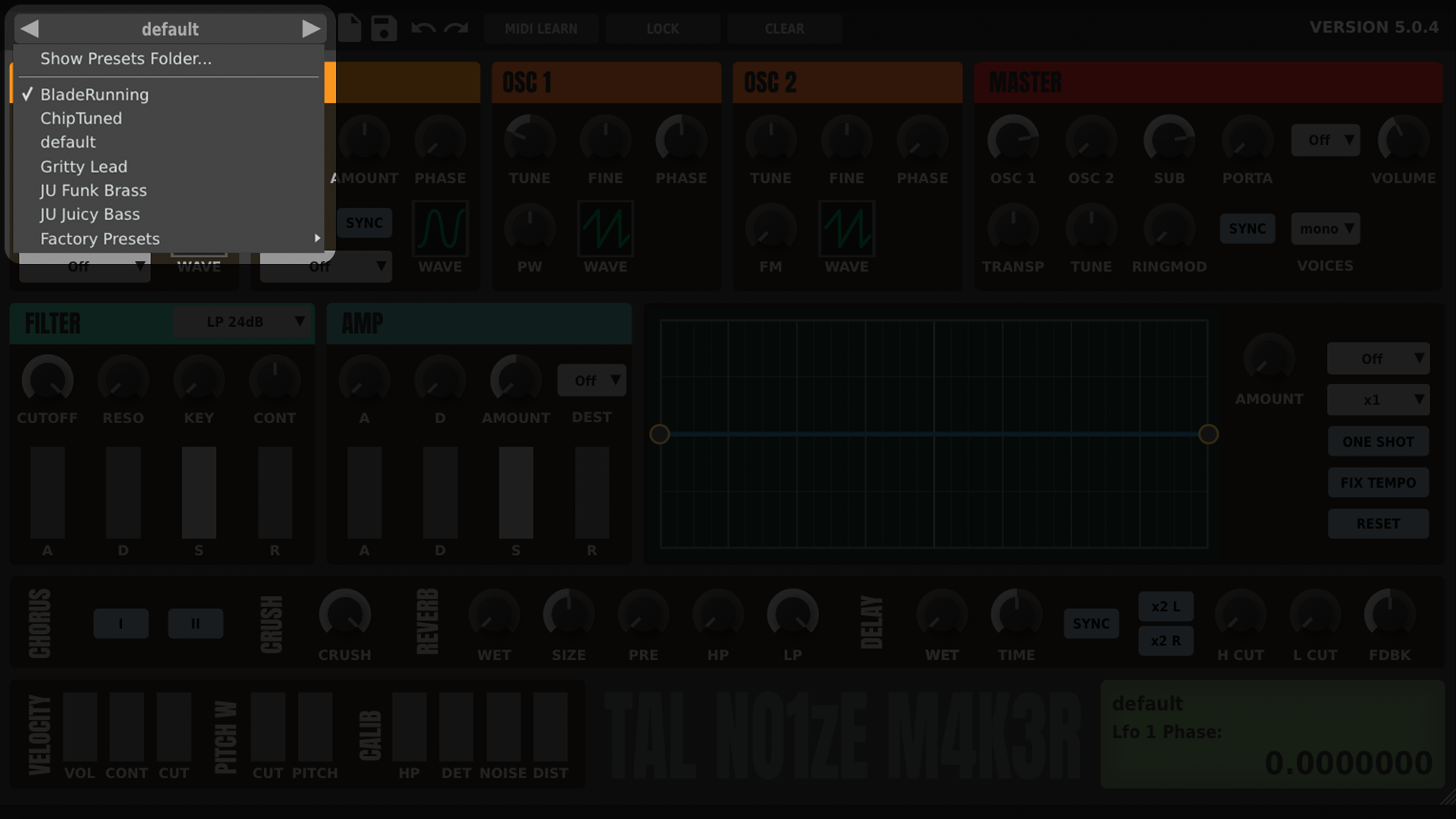
Preset 1: BladeRunning

This preset demonstrates NoiseMaker’s potential for large, juicy, evolving pad-tones. It’s fairly complex, utilising multiple envelopes and LFOs in subtle ways to move and modulate the sonic-picture, so as to keep an element of movement in the tone and prevent it from feeling static.
OSCs
- Both OSC1&2 are set to Saw wave-shapes with one at -2 octaves, the other at -1 octave. This is necessary for achieving both bright upper harmonics and the depth of tone required for bass
- FINE-TUNE is nudged ever so slightly apart on each OSC to thicken the tone
MASTER
- Some SUB dialled in to add low-frequency body to the tone
- VOICES set to mono with a small amount of (AUTO) PORTA to help enhance expressiveness
FILTER
- Enveloped so that the tone begins with a medium-brightness but gradually brightens if held
- The long release means the envelope will still continue to raise the brightness after key-release (in relation to the AMP ENV’s release tail)
AMP
- Straight forward pad-like settings of slow attack, maximum sustain, slow release
LFOs
- LFO1 is subtly modulating the pitch of OSC1&2, intended to keep a sense of motion on held chords
- LFO2 is subtly modulating the pan, moving the weight of the tone gently from left to right, also intended to help enhance a sense of movement and interest over time
- Both LFOs are synced to the DAW tempo
ENV EDITOR
- Assigned to volume and synced to the DAW tempo, creating a gentle Tremolo effect in time with your production
EFFECTS
- Both CHORUS are active for maximum widening and further enhancing the out-of-sync fine tuning of OSC1&2
- Heavy REVERB saturation for atmosphere
- DELAY synced to 1/2 of the DAW tempo and the high-cut is turned down so that delay tails are less bright
VELOCITY / PITCH WHEEL / CALIB
- Maximum VELOCITY sensitivity
- CUTOFF and CONTOUR also affected by VELOCITY (for expressiveness when playing)
- PITCH wheel set to 2 semitones
- Significant DETUNE to (even) further enhance the chorus illusion and width of tone
- A little NOISE and DISTORTION for added colour and interest
Preset 2: JU Juicy Bass
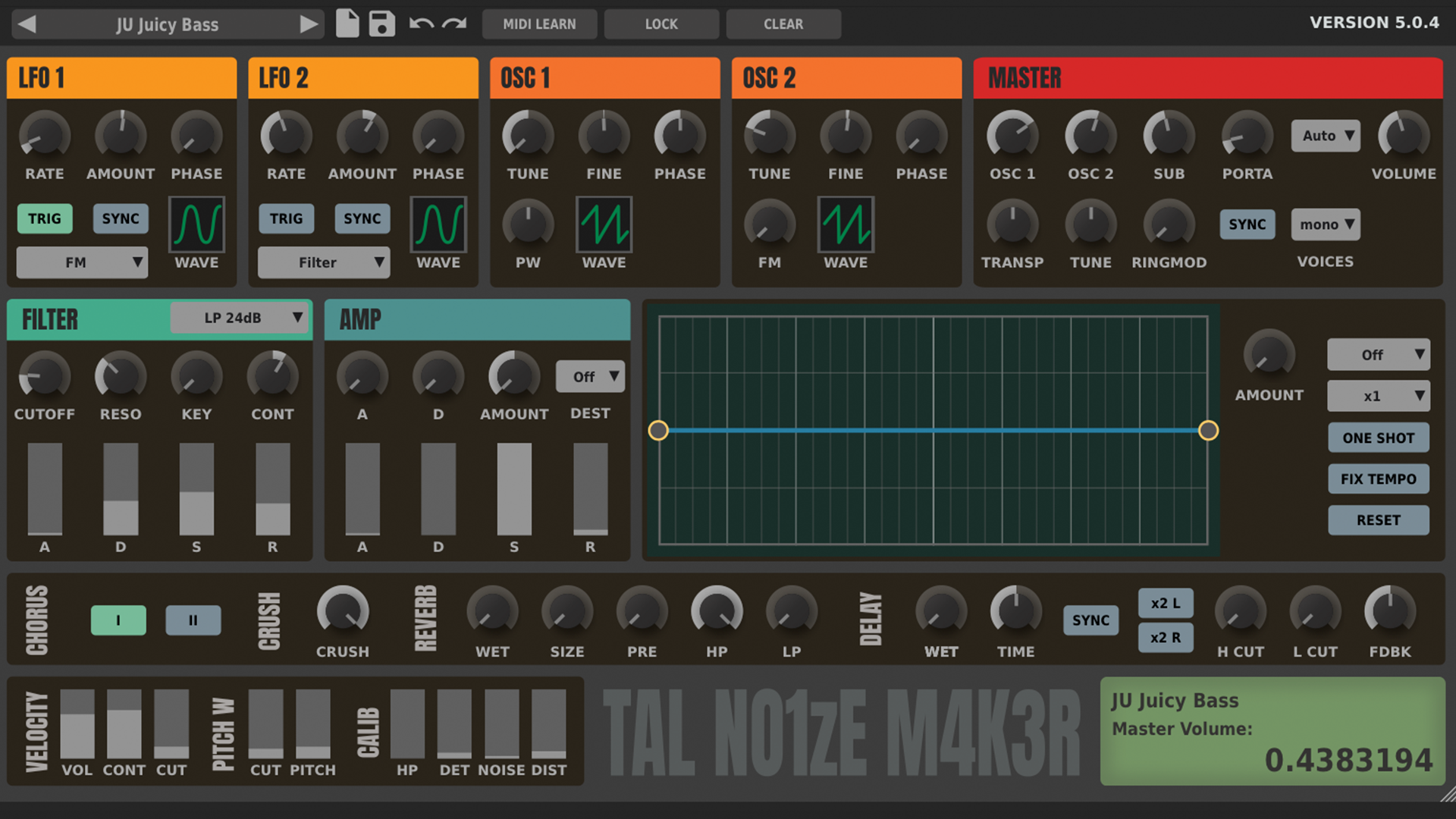
This preset demonstrates NoiseMaker’s potential for detailed, full-bodied and energetic bass tones. It’s modelled on the sort of bass tones that are popular in electro-funk and acid-house genres, and which are often created on the iconic Roland Juno (hence the “JU” in the patch name).
OSCs
- Both OSC1&2 are set to Saw wave-shapes with one at -2 octaves, the other at -1 octave. This is necessary for achieving both bright upper harmonics and the depth of tone required for bass
- FINE-TUNE is nudged ever so slightly apart on each OSC to thicken the tone
MASTER
- Some SUB dialled in to add low-frequency body to the tone
- VOICES set to mono with a small amount of (AUTO) PORTA to help enhance expressiveness
FILTER
- FILTER ENV dialled in quite aggressively to give the tone bite in the initial transient of the tone
AMP
- Sustain is maxed out, with just tiny amount of Attack and Release to stop the tone from clicking
LFOs
- LFO1 subtly modulates OSC2’s FM in trigger mode, so that every note press has an additional element of FM bite and character within the upper-harmonics
- LFO2 is gently modulating the FILTER. Whilst this tone is mostly designed with short, staccato notes in mind, this gentle inclusion of an LFO of the FILTER is for any long-held notes that may require a little modulation and movement over time
EFFECTS
- CHORUS1 is active for additional colour
VELOCITY / PITCH WHEEL / CALIB
- Significant VELOCITY sensitivity for expression
- CUTOFF and CONTOUR also affected by VELOCITY
- PITCH wheel set to 2 semitones
- CUTOFF is also affected by the pitch-bend, so that pitch bends brighten up for added expression
- A very small amount of DETUNE, NOISE and DISTORTION for added colour
Preset 3: Gritty Lead

This preset demonstrates NoiseMaker’s potential for punchy, powerful leads (which can also double as very energetic bass tones). This is another fairly complicated patch with a lot of focus on the initial transients of the soundwave.
OSCs
- Both OSC1&2 are set to Saw wave-shapes and -1 octave to bring them in-line with the SUB OSC
- FINE-TUNE is nudged apart on each OSC to induce an element of detune, natural chorus and overall tonal widening
- OSC2 has ample of FM to enhance the bite and colour of the tone
MASTER
- SUB set similar to OSC1&2 for low-end oomph
- VOICES set to mono with a small amount of (AUTO) PORTA to help enhance expressiveness
FILTER
- FILTER ENV dialled in quite aggressively to give the tone bite in the initial transient of the tone
AMP
- Sustain is set to max, with just a tiny amount of Attack to stop it clicking upon key-trigger. The Release has a little slowness to it, to give it a little tail and character
LFOs
- LFO1 is subtly modulating the pitch of OSC1&2, intended to keep a sense of motion on held notes
- LFO2 is synced to the DAW tempo and is modulating the pan to enhance the stereo picture
ENV EDITOR
- Assigned to OSC2 FM with a single (ONE SHOT) spike at the start of the signal, so that it plays once on every note. This gives the tone an aggressive FM bite in the initial transient.
EFFECTS
- CHORUS1 is active for additional colour
- Medium REVERB saturation for a little atmosphere
- DELAY synced to 1/16T of the DAW tempo and set to enhance the excitement of the tone
VELOCITY / PITCH WHEEL / CALIB
- Heavy VELOCITY sensitivity
- CUTOFF and CONTOUR also affected by VELOCITY (for expressiveness when playing)
- PITCH wheel set to 2 semitones
- A modest amount of DETUNE, NOISE and DISTORTION for added colour
Preset 4: JU Funk Brass
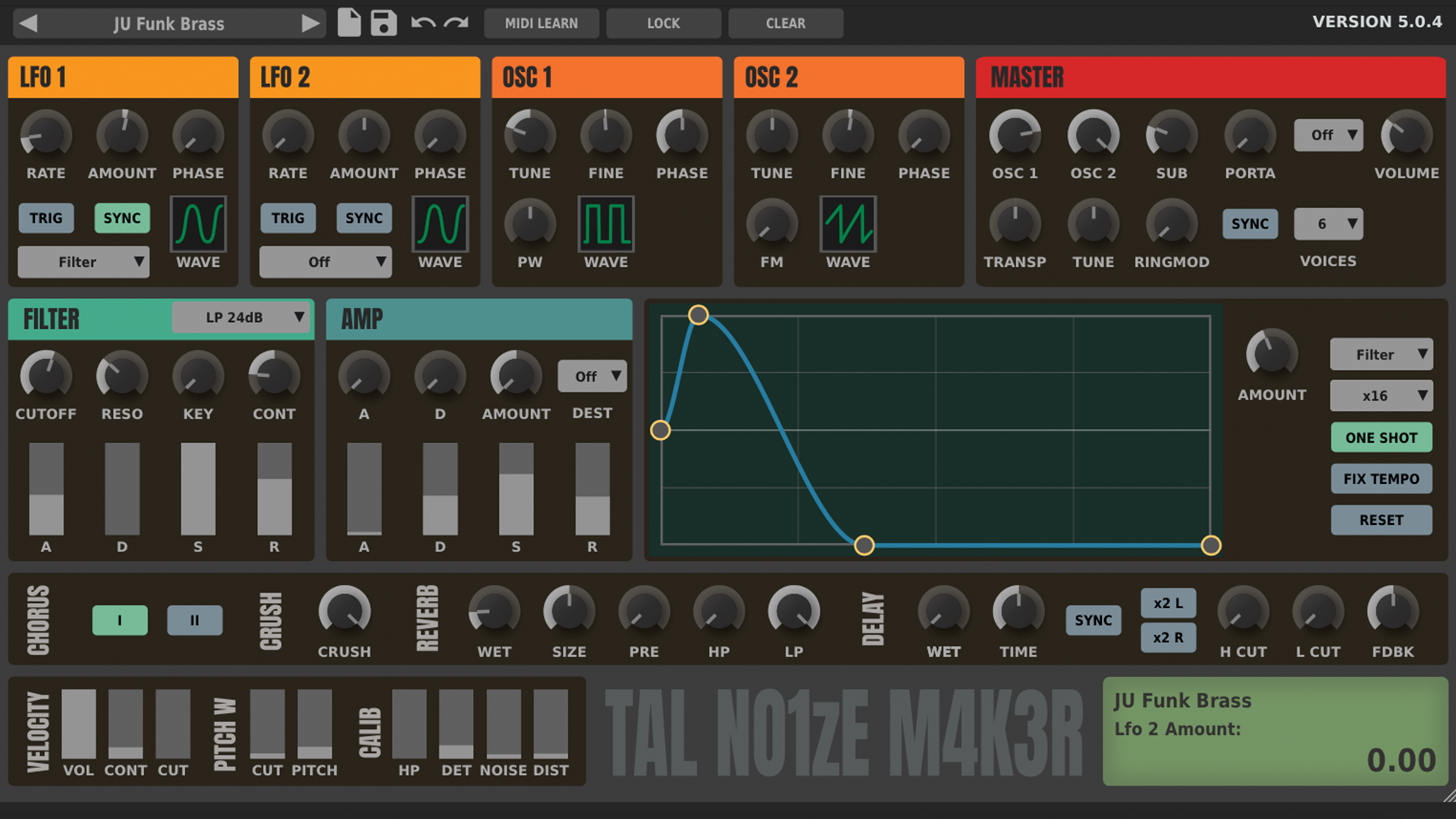
This present demonstrates NoiseMaker’s potential for vintage 1980s tonalities. Whilst the bass preset above takes inspiration from the Roland Juno, this patch is aimed at further capturing a Junoesque brass tone, which is extremely versatile and works well for all sorts of things, from funk to power ballads, or synth-pop to deep house.
OSCs
- OSC1 is a Square wave-shape -1 octave to add some depth and compliment the SUB OSC
- FINE-TUNE is nudged apart on each OSC to induce an element of detune, natural chorus and overall tonal widening
- OSC2 is a Saw wave-shape
MASTER
- OSC2 is maxed out, whilst OSC1 and SUB are set to lower levels. This gives the Saw the predominant tonal presence, however there’s a gentle depth provided by OSC1 and SUB
- VOICES are maxed out for large chord potential
FILTER
- FILTER ENV begins bright, but softens. The RESO is fairly high to add some resonant colour to the filter-sweep
SUSTAIN
- Sustain is set to approx. three quarters, enhancing the initial swell of the Attack and Decay
LFOs
- LFO1 is subtly modulating the FILTER, to keep some movement in the tone on held notes
ENV EDITOR
- Assigned to the FILTER with a (ONE SHOT) single spike at the start of the signal, to enhance the initial brightness of the transient (in an attempt to further capture a brassy quality)
EFFECTS
- CHORUS1 is active for additional colour
- Medium REVERB saturation for a little atmosphere
VELOCITY / PITCH WHEEL / CALIB
- Maximum VELOCITY sensitivity
- CUTOFF is slightly affected by VELOCITY (for expressiveness when playing)
- PITCH wheel set to 2 semitones
- CUT-OFF is slightly enhanced on pitch-bend
- A modest amount of DETUNE, NOISE and DISTORTION for added colour
Preset 5: ChipTuned

This last preset is a bit of fun which also shows the potential NoiseMaker has for diversity. This preset emulates the characteristic of 8-bit video game sounds and could be useful for anyone looking to sprinkle some chip-tune tonalities on their music.
OSCs
- OSC1&2 are both Square wave-shapes
- OSC1 is tuned down an octave for a wider tonal shape
- FINE-TUNE nudged apart on each OSC to induce an element of detune, natural chorus and overall tonal widening
MASTER
- OSCs are mixed to taste (keep in mind the SUB is a Square wave-shape, so it’s all very Square on this preset)
- The transpose is set to +2 Octaves (as OSC1 is -1 octave, it is now working with the SUB to provide the bulk of the tone. OSC2 is now 2 octaves higher and provides a bright overtone)
FILTER
- CUTOFF and RESO are both quite high, giving the tone lots of sparkle
- The FILTER ENV is works to slightly soften the tone across a note’s duration
AMP
- There is almost no Attack and there is no Sustain. Therefore the note rapidly fades away according to the Decay and Release. This gives it a pluck characteristic.
LFOs
- LFO1 is not in use
- LFO2 is very rapidly modulating amplitude with a Square wave-shape. This is what gives the tone its shimmer quality (note the AMOUNT is almost, but not quite set to 100% - this is to prevent clicking/popping when the straight edge of the Square wave-shape instantly changes the volume from minimum to maximum)
EFFECTS
- CHORUS1 is active for additional colour
VELOCITY / PITCH WHEEL / CALIB
- Maximum VELOCITY sensitivity
- PITCH wheel set to 2 semitones
- A modest amount of DETUNE and NOISE for added colour
Final thoughts...
As you can see, this synth is pretty comprehensive, especially for a freebie. Furthermore, it’s capable of a wide range of tonalities. On top of the tutorial presets we’ve provided, we’d recommend using any/all presets that come as standard with the synth, as foundations or starting points for crafting your own tones.
Whilst this synth is superb, it does have a couple of drawbacks. Most notably (for me), it doesn’t support mod-wheel input and therefore any vibrato you wish to add needs to be manually added by assigning an LFO to OSC pitch and automating the LFO Amount at the desired times.
Perhaps you could manually assign a trigger in your DAW’s configuration for this, but it’s a shame it doesn’t do it as standard. It also doesn’t appear to support sustain-pedal functionality. However, in the grand scheme of things, these are small issues that are easy to work around and mustn’t put you off this synth (it is free after all!).
To sum up, the TAL-NoiseMaker can be a powerful addition to your arsenal of instruments, and we suspect that if you download it, it will find its way into your music production one way or another. There’s a lot to be gained from freeware, as long as you know how to get the most out of it.


“OSC” Steve is a composer, producer and educator with a background in piano, synthesisers and sound-engineering. He is an established, independent artist in the Synthwave and Retrowave music scenes, and has composed for several independent video-games including Nintendo Switch™ titles.
“Excels at unique modulated timbres, atonal drones and microtonal sequences that reinvent themselves each time you dare to touch the synth”: Soma Laboratories Lyra-4 review
“A superb-sounding and well thought-out pro-end keyboard”: Roland V-Stage 88 & 76-note keyboards review




